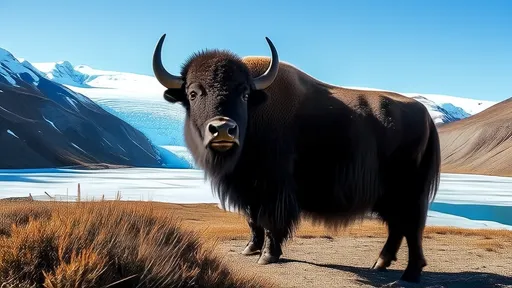The vast and rugged expanse of the Tibetan Plateau, often referred to as the "Roof of the World," presents one of the most extreme environments on Earth. With its thin air, freezing temperatures, and scarce vegetation, survival here is a formidable challenge. Yet, one creature has not only adapted but thrived in these harsh conditions—the yak. A recent breakthrough in genomic research has unveiled the genetic secrets behind the yak's remarkable resilience, offering a fascinating glimpse into the evolutionary marvels of this iconic species.
For centuries, yaks have been indispensable to the livelihoods of Tibetan pastoralists, providing milk, meat, fiber, and transportation. Their ability to endure altitudes exceeding 4,500 meters, where oxygen levels are critically low and temperatures plummet below -40°C, has long intrigued scientists. Now, a comprehensive study of the yak genome has identified key genetic adaptations that enable these animals to flourish where most others would perish. The findings not only deepen our understanding of evolutionary biology but also hold potential implications for medicine and agriculture.
The Genetic Blueprint of Survival
Researchers sequenced and analyzed the genomes of wild and domestic yaks, comparing them with those of cattle and other bovids. What emerged was a detailed map of genetic mutations and selective pressures that have shaped the yak's physiology. One of the most striking discoveries was the identification of genes associated with hypoxia adaptation. Unlike lowland mammals, yaks exhibit unique variations in genes related to blood vessel formation and oxygen transport, allowing them to maintain efficient metabolism even in oxygen-deprived environments.
Another critical adaptation lies in the yak's energy utilization. The plateau's sparse vegetation means yaks must extract maximum nutrients from limited food sources. Genomic analysis revealed enhancements in genes responsible for digestion and metabolic efficiency, particularly those involved in breaking down fibrous plants. These adaptations enable yaks to convert tough, high-altitude grasses into energy more effectively than their lowland relatives.
Cold Resistance: A Molecular Masterpiece
The bitter cold of the Tibetan Plateau demands extraordinary measures to prevent frostbite and maintain core body temperature. The yak genome showcases a suite of innovations tailored to this challenge. For instance, genes regulating fat metabolism and insulation are highly active, leading to a thick layer of subcutaneous fat and a dense, long coat that traps heat. Additionally, yaks possess specialized proteins that prevent their blood from freezing, a trait shared with few other mammals.
Perhaps even more remarkable is the yak's ability to regulate its body temperature during extreme fluctuations. Researchers identified mutations in thermoregulatory genes that allow yaks to conserve energy during blizzards while avoiding overheating under the intense ultraviolet radiation common at high altitudes. This delicate balance is a testament to the precision of natural selection in crafting a survivor.
Implications Beyond the Plateau
The insights gleaned from the yak genome extend far beyond academic curiosity. Understanding how these animals cope with hypoxia could inform treatments for human conditions such as altitude sickness and cardiovascular diseases. Similarly, the genetic mechanisms behind cold resistance might inspire new approaches to preserving organs for transplant or designing protective gear for extreme environments.
In agriculture, the yak's efficient nutrient absorption and energy metabolism could guide the breeding of hardier livestock capable of thriving in marginal lands, a pressing need as climate change alters global ecosystems. By studying the genetic toolkit of the yak, scientists may unlock strategies to enhance food security in some of the world's most vulnerable regions.
Preserving a Genetic Treasure
As valuable as these discoveries are, they also underscore the importance of conserving the yak and its habitat. Climate change and overgrazing threaten the delicate balance of the Tibetan Plateau, putting both wild and domestic yak populations at risk. Protecting this genetic reservoir is not just about safeguarding a species—it's about preserving a living library of evolutionary innovation that may hold answers to some of humanity's greatest challenges.
The yak's genome is a testament to life's incredible ability to adapt and endure. In its DNA lies a story of resilience written over millennia, a story that continues to unfold as science reveals new layers of complexity. As researchers delve deeper into this genetic goldmine, one thing becomes clear: the humble yak has much to teach us about survival in an ever-changing world.

By /Jul 14, 2025

By /Jul 14, 2025

By /Jul 14, 2025

By /Jul 14, 2025

By /Jul 14, 2025

By /Jul 14, 2025

By /Jul 14, 2025

By /Jul 14, 2025

By /Jul 14, 2025

By /Jul 14, 2025

By /Jul 14, 2025

By /Jul 14, 2025

By /Jul 14, 2025

By /Jul 14, 2025

By /Jul 14, 2025

By /Jul 14, 2025

By /Jul 14, 2025

By /Jul 14, 2025